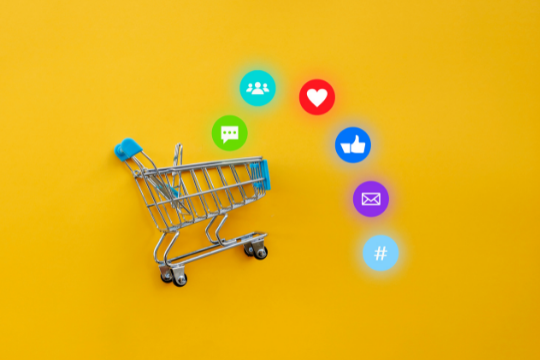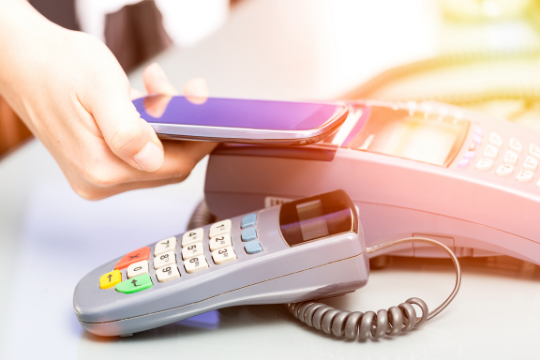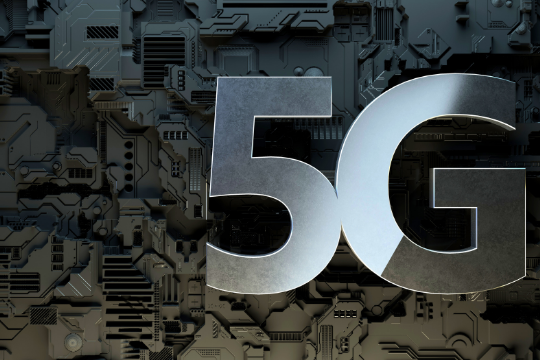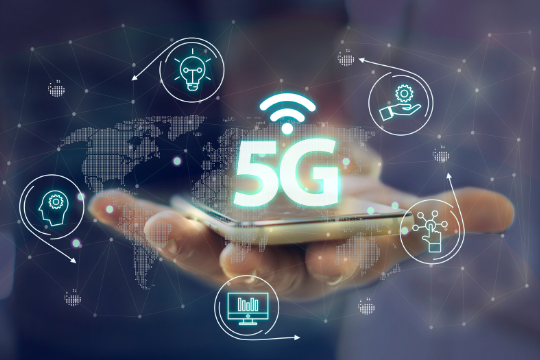 For several years now people have increasingly shifted their shopping interest to the internet, but with the growing popularity of smartphones, eCommerce is shifting once again. This time it is moving to mobile applications. Several apps are currently available including Wanelo, Polyvore, Instagram, and Pinterest. They are changing the way people shop, but do they have a positive or negative impact on consumer and retailer behaviors with these social media shop features?
For several years now people have increasingly shifted their shopping interest to the internet, but with the growing popularity of smartphones, eCommerce is shifting once again. This time it is moving to mobile applications. Several apps are currently available including Wanelo, Polyvore, Instagram, and Pinterest. They are changing the way people shop, but do they have a positive or negative impact on consumer and retailer behaviors with these social media shop features?
Background of Social Media Shopping Features
Social media is expanding its reach into the realm of shopping, and it’s already made an impact on retail. An increasing number of brands are using social media as a platform to interact with consumers and exchange ideas about products. Many sites like Facebook and Instagram allow companies to communicate directly with their consumers and share pictures and information about new products and sales. However, many sites have begun to offer much more than communication between company and consumer; they now provide consumers with an opportunity to shop directly from the site, using their social media as a platform for selling rather than just communicating.
The idea is that consumers are more likely to buy products that they have seen their friends use or endorsed by their favorite influencers.
Since the widespread use of social media, many sites have adopted ‘click-to-buy’ features to encourage purchasing while still on the site. These features allow users to click directly through advertisements for deals and purchase products, without ever having to leave the platform. Amazon has been using this model for years and it’s led them to become the largest online retailer, so many sites have been eager to follow suit. In light of Amazon’s growing dominance, other retailers have begun offering click-to-buy shopping features on their social media pages. For example, Walmart recently allowed customers to purchase items directly through Facebook using shop-by-photo technology that allows users to purchase an item by photographing it with the site’s camera.
List of Social Media Apps That Offer Shopping Features
The following are social media sites that have recently integrated shop-by-photo technology, allowing users to purchase items directly through the site.
Facebook allows you to buy products from companies by directly clicking on advertisements within their Facebook page. This feature provides customers with the ability to browse deals and order products without ever having to leave the platform or wait to get back to their laptop or phone. One way Facebook encourages these transactions is through its ‘Marketplace’ feature, allowing users to buy and sell items within the social media site. This provides an opportunity for increased exposure of products and increased revenue for the company by allowing users to only advertise items that are actually available.
Instagram has created a similar platform for online retailers to sell directly through their site. Users are able to click on advertisements and purchase items without leaving the site, creating an easy shopping experience for consumers. This allows brands to effortlessly reach more people looking for deals and products, all within one convenient platform. Some companies have even begun promoting deals exclusively through the app.
While Facebook and Instagram are primarily focused on person-to-person sales, Twitter has created an opportunity for companies to sell directly through their feed. Similar to Facebook, Twitter allows brands to share pictures of deals and new products, encouraging consumers to purchase them. They also offer an opportunity for direct communication with customers by allowing users to mention companies within tweets that will then be directed back to the original tweet. This is advantageous for businesses because it provides a platform where they can easily interact with their followers and provide exclusive deals and special products.
The birthplace of the popular ‘buy button,’ Pinterest has taken buying products from social media to a whole new level. The newest addition to its ever-evolving platform, the site now allows users to directly purchase items by clicking on a ‘buy button’ next to product pins. Because of its growing popularity within the social media world, many brands have begun promoting their products exclusively on Pinterest.
Etsy
The eCommerce website specializes in handmade goods, vintage items, and supplies for other small businesses. With the goal of ‘creating a more fulfilling shopping experience,’ Etsy encourages consumers to shop directly through its site by allowing customers to click on products pinned from sellers’ pages and be directed back to their product page. This provides customers with an opportunity to interact directly with sellers while also providing additional revenue for the company.
The Good: Why Shopping Through Social Media is Beneficial to Businesses and the Economy
While the idea of being able to directly purchase items from social media sites like Facebook and Instagram may seem like a luxury for consumers, it actually provides many benefits within the economy. Here are a few of them.
Increased Revenue for Brands and Sellers
One of the primary benefits of shopping through social media platforms is that companies can easily sell products directly to consumers. This provides an opportunity for increased revenue because companies no longer have to pay for ads in newspapers or other third-party distribution channels. By selling products directly to customers, sellers are able to increase their profits. Some social media sites even allow users to tip the brand or individual seller after purchasing an item, which provides another potential source of income. This allows brands and businesses to keep more money and put it back into the economy.
Increased Exposure and Sales for Small Businesses
Small businesses and entrepreneurs benefit from selling their products through social media because they can easily increase their customer base without having to spend additional money on advertisements. Some of these platforms, such as Etsy, allow small businesses and individual sellers to remain anonymous while promoting their products. This increased exposure not only benefits the business, but also helps customers make better purchasing decisions since they have a wide variety of brands and sellers to choose from.
Increased Accessibility for Consumers
One of the reasons social media allows customers to become more invested in a brand or company is because it provides them with immediate access to a business. If a user finds a brand or product they like, all they have to do is follow the seller through their social media page and purchase an item directly from them. This increased accessibility allows consumers to shop at any time of the day while also giving them more purchasing power because many social media platforms allow for free shipping or money off certain products.
The Bad: Problems with Social Media Shopping
While there are many benefits to social media and online shopping, there are also some disadvantages.
Price Variance and Inaccurate Search Results
One of the downsides to shopping through social media is that prices might not be as competitive as those on larger eCommerce sites. Because brands compete with each other to gain more followers, they are more likely to lower their prices in order to attract consumers. This results in a lack of transparency for the customer because they are no longer able to see if products are being sold at fair market values or not. It can also create problems for brands that choose to sell on multiple social media channels since prices might vary based on the site.
Once a product has been found on social media, the customer might have to navigate through several different links in order to reach the original pinned item. This is because products are usually separated into similar categories and then arranged in an alphabetical sequence. Although this makes it easier for brands and sellers to organize their goods, it can make it difficult for customers to search through relevant items. This is because links might not always lead directly to the product page, which decreases the chances of a sale for brands and sellers.
Additional Costs Associated with Shipping
Another downside to shopping on social media sites like Facebook or Instagram is that prices usually do not include shipping. This results in the customer having to pay an additional fee on top of the product cost, which can be either time consuming or expensive for them. Although some social media platforms do put a cap on how much buyers have to spend before they qualify for free delivery, brands are more likely to make their customers incur these costs because it increases the chances of a sale.
User Friendliness
One final problem with social media shopping is that it can be difficult for customers to sort through all of the different products being sold on these channels. This is because each seller designs their own unique page depending on their preferences, which can make it challenging for users to find what they are looking for. On top of this, most social media sites are not optimized to run on desktop computers, which can make it time consuming for customers to complete purchases if they do not have a smart phone or tablet with them.
Although social media has allowed people to interact with brands in new and exciting ways, the ease of shopping through these channels creates some negative consequences for customers and sellers alike. For consumers, increased accessibility can cause problems with search results, price variance, and shipping costs. Brands also face challenges with organizing their products for sale on multiple sites and creating user-friendly interfaces that can be used across different technologies. Because social media shopping is still relatively new, it might be difficult to predict how these problems will shape the future of eCommerce. As more brands begin to sell goods directly through social media, customers might find that prices become more competitive and their searches improve over time.
Sunvera Software develops next-level software applications from start-to-finish. We are a premier software and mobile app development agency specializing in healthcare mobile app development, custom mobile app development, telehealth software, sales dashboards, custom mobile app development services, retail software development, supply-chain software, ecommerce, shopify, web design, iBeacon apps, security solutions and unified access software.
We are proud partners with Amazon AWS, Microsoft Azure and Google Cloud.
Schedule a free 30-minute call with us to discuss your business, or you can give us a call at (949) 284-6300.
 UWB technology and AI have been hot topics in the retail industry for a while now. If you’re only recently becoming aware of it, you’ve got some catching up to do. In particular, UWB’s potential to add value in retail technology applications is very exciting right now. In this article, we’ll take a look at five ways these technologies are being used to improve the retail experience and drive real value to retailers and consumers alike.
UWB technology and AI have been hot topics in the retail industry for a while now. If you’re only recently becoming aware of it, you’ve got some catching up to do. In particular, UWB’s potential to add value in retail technology applications is very exciting right now. In this article, we’ll take a look at five ways these technologies are being used to improve the retail experience and drive real value to retailers and consumers alike. Artificial intelligence (AI) is one of the most talked-about and important technologies today and this isn’t going to change anytime soon. In fact, AI is likely to play a major role in transforming organizations from being knowledge-driven to being data-driven. In this post, we’ll explore why it’s important to add AI into your HR tech stack and discuss how you can tackle some common challenges using this technology.
Artificial intelligence (AI) is one of the most talked-about and important technologies today and this isn’t going to change anytime soon. In fact, AI is likely to play a major role in transforming organizations from being knowledge-driven to being data-driven. In this post, we’ll explore why it’s important to add AI into your HR tech stack and discuss how you can tackle some common challenges using this technology. The Fintech and banking industry is in a constant state of innovation and one of the most important tech areas that will allow this to continue for years to come is Artificial Intelligence (AI). Finance professionals who are leading their organization’s AI efforts need to understand evolving customer expectations, evolving threat vectors, and internal capabilities such as culture, tech, and data infrastructure to pull off successful AI initiatives.
The Fintech and banking industry is in a constant state of innovation and one of the most important tech areas that will allow this to continue for years to come is Artificial Intelligence (AI). Finance professionals who are leading their organization’s AI efforts need to understand evolving customer expectations, evolving threat vectors, and internal capabilities such as culture, tech, and data infrastructure to pull off successful AI initiatives. Ultra-Wideband (UWB) technology is capable of delivering and receiving high data rates and resolving propagation path variations, such as multipath and shadowing. UWB can be used in various application fields for wireless communications, remote sensing, imaging, and target tracking. Logistics operations need to implement this technology due to its ability to address logistics problems such as inventory management and vehicle tracking.
Ultra-Wideband (UWB) technology is capable of delivering and receiving high data rates and resolving propagation path variations, such as multipath and shadowing. UWB can be used in various application fields for wireless communications, remote sensing, imaging, and target tracking. Logistics operations need to implement this technology due to its ability to address logistics problems such as inventory management and vehicle tracking. 5G technology has been hailed as the new golden child of the tech world. It is expected to have speeds 100 times faster than current 4G networks, increase connection capacity by 1,000 times, and pave the way for new technologies we can’t even imagine yet.
5G technology has been hailed as the new golden child of the tech world. It is expected to have speeds 100 times faster than current 4G networks, increase connection capacity by 1,000 times, and pave the way for new technologies we can’t even imagine yet.
 There’s been a lot of talk about the benefits of 5G and how it will change the world as we know it. We know that it’s fast and efficient, but how is it different? Can it help our environment?
There’s been a lot of talk about the benefits of 5G and how it will change the world as we know it. We know that it’s fast and efficient, but how is it different? Can it help our environment? When we speak of mental health in the workplace, we’re referring to the overall well-being of employees—not job performance, although the latter is often a reflection of the former. A number of aspects in one’s personal life can influence someone at work, but also the workplace itself. Stressful environments and pushy bosses putting too much pressure on employees, with little positive reinforcement, coupled with a highly competitive atmosphere, which, in moderation, could be healthy, if devoid of an overall sense of teamwork and collaboration, becomes destructive.
When we speak of mental health in the workplace, we’re referring to the overall well-being of employees—not job performance, although the latter is often a reflection of the former. A number of aspects in one’s personal life can influence someone at work, but also the workplace itself. Stressful environments and pushy bosses putting too much pressure on employees, with little positive reinforcement, coupled with a highly competitive atmosphere, which, in moderation, could be healthy, if devoid of an overall sense of teamwork and collaboration, becomes destructive. As you know, private messaging apps are very popular nowadays. Businesses use them to simplify their interactions with customers and employees, and people use them to avoid the annoyance of unwanted advertising. There are lots of people who use it to express their thoughts and emotions. Some messaging apps are more widely used than others, even though there are plenty of great ones out there offering an excellent chat experience.
As you know, private messaging apps are very popular nowadays. Businesses use them to simplify their interactions with customers and employees, and people use them to avoid the annoyance of unwanted advertising. There are lots of people who use it to express their thoughts and emotions. Some messaging apps are more widely used than others, even though there are plenty of great ones out there offering an excellent chat experience.
